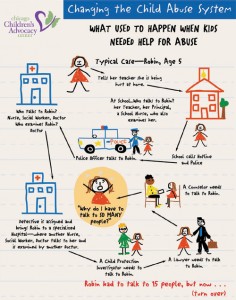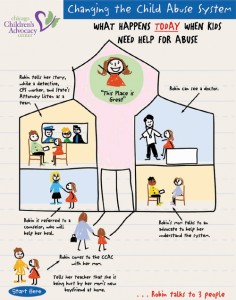Children deserve a well coordinated response to child abuse.
 The #1 indicator that a child has been abuse, is if that child tells he or she have been abused. Before Children Advocacy Centers, children would have to be tell up to 15 different adults that they may have been abuse. As a result many families would drop out of the investigation process, never getting the help they needed. Other problems at this time included: no transportation assistance for families to participate in the investigation, lack of communication among protective service systems, no connection to treatment and services, as well as low arrest and prosecution rates.
The #1 indicator that a child has been abuse, is if that child tells he or she have been abused. Before Children Advocacy Centers, children would have to be tell up to 15 different adults that they may have been abuse. As a result many families would drop out of the investigation process, never getting the help they needed. Other problems at this time included: no transportation assistance for families to participate in the investigation, lack of communication among protective service systems, no connection to treatment and services, as well as low arrest and prosecution rates.
The child advocacy center model developed through Former Congressman Bud Cramer’s vision to pull together law enforcement, criminal justice, child protective service, medical and mental health workers into one coordinated team. The first Children’s Advocacy Center opened in Huntsville, Alabama opened in 1985.
A Children’s Advocacy Center is a child-focused, facility-based program in which representatives from many disciplines, including law enforcement, child protection, prosecution, mental health, medical, and victim advocacy, work together to conduct interviews and make team decisions about the investigation, treatment, management and prosecution of child abuse cases.
From that first center in Huntsville, a national grassroots movement was created. Today, there are nearly 800 independent children’s advocacy centers nationwide.
Now children tell their story in one place, one time.
A CAC addresses the following systemic problems:
Child maltreatment victims are less traumatized when agencies work together and when professionals come together in one location.
When a trained professional conducts a forensic interview with the child in a non-leading, legally-sound, developmentally appropriate manner, the information that is gathered is more reliable, resulting in better informed decisions about protection, prosecution and treatment.
Treatment and support services being within days: both children and non-offending family members receive immediate crisis intervention and referrals for services.
There is a $1,318* cost savings per case when the CAC model is used in responding to child abuse cases versus the traditional Law Enforcement/Child Protective Services investigation approach.
Each CAC works individually and in partnership with a network of national leadership and support to ensure that communities across the country are working together to help ensure that child abuse victims have access to a well coordinated and family friendly child abuse response. Visit OUR PARTNERS to learn more.

